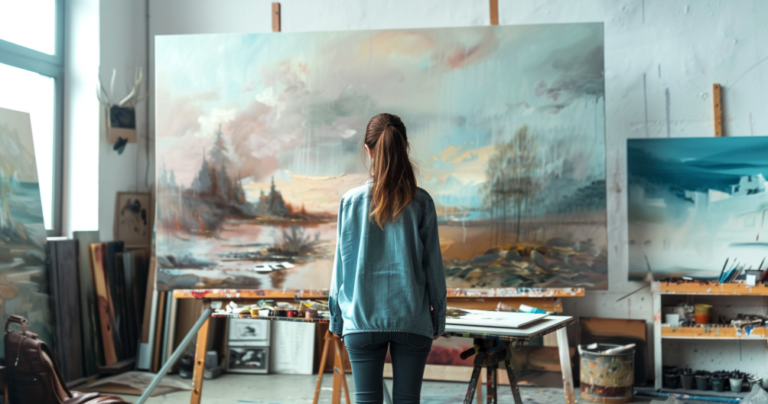What makes **good art**? Folks often wonder about this in art chats. The answer usually depends on personal likes and how one views fine art. Still, there’s a general agreement on some features that boost how an artwork is valued.
What Makes Art Good
Emotional connection is one of the key elements that might make art stand out. If a piece of art resonates with you, invoking a strong emotional response, it may be considered good from your perspective. Another important aspect is technical mastery. Artists who display exceptional craft skills are often praised for producing good art. Additionally, many believe good art should be unique and original, capturing the viewer’s attention and leaving a lasting impression.
Overall, it’s important to remember that what makes art good is often influenced by individual taste and perspective. Whether a piece speaks to you emotionally, showcases exceptional skill, or stands out as innovative or original, it’s ultimately up to you to decide what you consider good art.
Historical Context

Cultural Influence
It’s important to consider the cultural influence when determining what makes art good. Different cultures have various standards for art, emphasizing diverse elements and themes. For example, Japanese art may focus more on the simplicity and harmony of nature, while Western art might emphasize realism and the human form. The context of the artwork’s creation also plays a role in our appreciation. Please spend some time examining the cultural background of a piece to deepen your understanding of its significance.
- Japanese art – simplicity, harmony with nature
- Western art – realism, human form
Evolution of Standards
Art has not remained static throughout history; it has evolved alongside human society and its changing values. Standards for what makes art “good” have shifted over time. Traditionally, European art was more about technical skill and adherence to specific rules, while modern and contemporary art values experimentation, originality, and personal expression. To better appreciate an artwork, it’s essential to understand how these standards have changed over time.
- Traditional European art – technical skill, rule adherence
- Modern and contemporary art – experimentation, originality, personal expression
When evaluating art, it’s essential to consider the historical context in which it was created. This includes the cultural influences that informed the artist’s work and the changing standards and expectations in the art world. By educating yourself on these aspects and examining them through a friendly and open-minded lens, you can better appreciate and understand what makes art “good” in the broader scope of history.
Aesthetics and Style

Form and Composition
The arrangement of elements within an artwork plays a crucial role in its overall appeal. A well-balanced composition can draw your eye to the focal points and create a sense of harmony. In contrast, a poorly composed piece may feel chaotic or confusing.
There are various principles that you can use to guide your understanding of form and composition, such as:
- Balance: Ensuring that visual weight is distributed evenly within the artwork.
- Proportion: The relative size of elements and how they relate.
- Unity: Creating a feeling of cohesion, where all aspects of the work feel connected and deliberate.
As you analyze an artwork, try to identify how these principles are employed and how they contribute to the piece’s overall success.
Color and Texture

Color and texture are essential components of an artwork’s aesthetic appeal. Artists can skillfully manipulate these elements to evoke specific emotions, establish a mood, or create visual interest.
When examining the use of color in artwork, consider the following:
- Hue: The pure colors used and the feelings they may elicit. For example, warm colors like red and orange can create a sense of energy, while cooler colors like blue and green may impart a sense of calm.
- Saturation: How vivid or muted are the colors? Higher saturation can produce an intense, vibrant effect, while lower saturation can give an artwork a more subdued, quiet appearance.
- Value: The range of lightness and darkness used within the piece. High contrast between light and dark can make an artwork dramatic, while a narrower range of values may create a more subtle, minimalistic effect.
Texture, on the other hand, is the tactile quality of the artwork’s surface. It can be actual (created by the physical materials used) or implied (suggested through visual techniques). As you explore texture within an artwork, consider how it contributes to the overall impression and whether it reinforces or contrasts with other elements.
By closely examining these aspects of aesthetics and style, you can gain a deeper appreciation for the factors that contribute to good art. Consider these considerations as you explore different artworks and develop your understanding of what makes art exceptional.
Emotional Impact

Audience Interpretation
Art is an incredibly personal experience: what moves one person might leave another completely unmoved. Understanding the emotional impact of a piece of art is important for defining its quality. As you engage with a piece of art, consider how it resonates with your emotions, memories, and experiences.
When evaluating art, it’s crucial to remember that each person interprets emotions differently. Some factors influencing your emotional response to a piece of art include reduced stress and anxiety or an association with a specific memory. Keep an open mind as you look at the artwork and allow yourself to be drawn into the piece.
Here’s a simple list to help guide your exploration:
- Identify the emotions that the artwork evokes.
- Think about why the artwork creates these emotions.
- Reflect on how the artist achieved this impact.
Provocation and Controversy
Sometimes, a piece of art is considered good because it creates a strong reaction. This may involve an element of provocation or controversy. Challenging social norms or asking daring questions can be a valuable aspect of art. This, in turn, helps us engage more deeply with the piece, making it more meaningful.
To better understand the relationship between an artwork and its provocative nature, you can follow these steps:
- Examine what aspects of the art provoke a reaction.
- Analyze how the artist utilizes these aspects to engage the audience.
- Assess whether the controversial elements strengthen or detract from the piece’s overall message.
Emotions are often closely tied to personal experiences and cultural backgrounds. Therefore, the emotional impact of a piece of art plays a significant role in determining what makes it good. By considering how art interacts with your emotions and the emotions of others, you can better understand the complexity and depth that makes a piece of art truly exceptional.
Critical Acclaim

Awards and Recognition
As an aspiring artist, you may wonder about the role of critical acclaim in determining what makes art good. Awards and recognition can be a significant factor in validating the quality of an artwork, as they showcase the approval of experts and industry professionals. Winning prestigious accolades, like the Turner Prize or the Pulitzer Prize for Visual Arts, can provide a sense of accomplishment and elevate an artist’s reputation.
When participating in exhibitions, receiving awards or recognition from respected institutions can also help boost your artistic career. Getting critical acclaim validates your work, widens your reach, and attracts more collectors to appreciate your art.
Expert Reviews
Another aspect of critical acclaim, and an important factor in gauging the quality of art, is the expert review. Professional art critics’ analysis and insights contribute to a deeper understanding of an artwork’s value and significance. Publications such as Artforum and Frieze feature reviews and essays on contemporary art, providing perspective on various works’ technical aspects, historical context, and unique qualities.
As an artist, when your work receives positive reviews from prominent critics, it adds an extra layer of credibility to your art. It helps establish you as a noteworthy figure in the art world. But remember, even the most highly-regarded artists have sometimes faced mixed or negative reviews. Staying true to your craft and growing as an artist are essential parts of your journey.
In summary, while critical acclaim should not be the sole benchmark for determining what makes art good, awards and expert reviews provide valuable insights and recognition. Striving for critical acclaim and embracing feedback can help you refine your artistic skills and enhance your reputation in the art world.
FAQ – What Makes Art Good
What does good art look like?
Good art effectively communicates, evokes emotion, provokes thought, demonstrates skill or innovation, and resonates with viewers. Its appearance can vary widely across styles and mediums.
What makes a successful artist?
A successful artist often combines creativity, unique vision, technical skill, persistence, and the ability to connect with an audience. Business acumen and networking also contribute to success in the art world.






